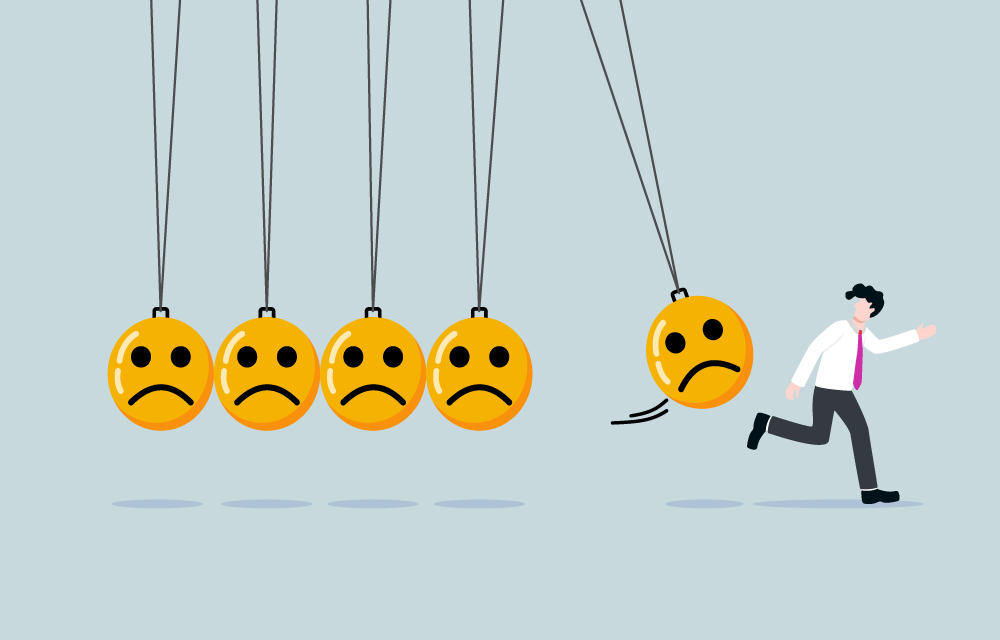years of wandering, the need for stability inevitably resurfaces, and you may find yourself back at a desk job again, trapped in a cyclical pattern.
This oscillating cycle creates a never-ending loop of shifting priorities that can drive both you and those around you to frustration. On this pendulum, there is no rest.
2. Sacrificing One Need for Another
Another scenario involves prioritizing one need while neglecting another, which can intensify over time. When this happens, there is always a lingering sense of discontent—part of you remains unfulfilled. This unmet need can breed internal conflict and negativity, creating an imbalance that ultimately leads to feelings of restlessness, emotional pain, depression, and a general sense of disconnection from joy and meaning in life.In Conclusion: The Ineffectiveness of Compromise
One reason many of us struggle to feel stable in our decisions is that we often stem from compromise. When an essential need remains unmet, it fosters considerable unrest regarding our choices. It's difficult to feel whole in such situations; indeed, it may be fitting not to feel whole since parts of your identity are being neglected. Our instincts, our very life force, are robust and seek to thrive; sometimes, that inner unrest is a healthy indication of change.Move Beyond Compromise!
While shifting away from compromise is a daunting task, it’s a journey worth undertaking. It starts with how we frame our thoughts.Cultivating Empowering Beliefs
Begin by fostering the belief that solutions exist which can cater to all your needs and desires. Discovering these solutions may call for unconventional and creative thinking. The very first step is to have faith that such resolutions are possible. As we navigate a culture that promotes compromise, we might need to step out of our comfort zones initially. With practice and reflection, the belief will strengthen—that solutions can arise to meet all aspects of your circumstances. This revelation can inspire determination and a steadfast pursuit of possibilities that lead away from compromise.Identifying Your Needs
To find the solutions that serve you best, identifying your needs is crucial. Engage in introspection to discern what needs are emerging in light of your challenges. Reflecting on these needs brings clarity and insight into the path forward. When considering various potential solutions, ask yourself what need each solution serves. Is it the need for financial stability? The desire for freedom? The want for security? Often, multiple needs are in play when we face dilemmas. Be mindful of the fears that arise—they can offer clues toward identifying what you truly need.Lets do it: Practical Steps for Implementation
When grappling with a challenging decision, take a moment to reflect on these four key questions:- What’s the first solution that comes to mind regarding this issue? What is your initial impulse?
- Which need does this solution address? What does it fulfill for you?
- Why do you feel hesitant to pursue this solution? What need remains unaddressed?
- What would an ideal solution look like for you? What needs must it fulfill to give you the assurance and confidence to move forward?
Example 1: David’s Culinary Aspiration
David has always harbored a passion for cooking, dreaming of becoming a professional chef. While working a stable marketing job, he spends his evenings exploring new recipes and hosting dinner parties. He recently discovered a prestigious culinary school that could help him transform his love for cooking into a career, but the tuition poses a significant concern, leaving him uncertain about making the leap. David reflects on the four questions:- What’s the first solution that comes to mind regarding this dilemma? What is your initial impulse? My first instinct is to enroll in culinary school immediately and begin my journey as a chef.
- Which need does this solution address? What does it fulfill for you? Enrolling satisfies my need for creative expression and allows me to delve into my passion, providing a sense of fulfillment that my current job lacks.
- Why do you feel hesitant to pursue this solution? What need remains unaddressed? I’m anxious about the tuition costs and doubtful about my ability to sustain a living as a chef. Leaving my stable job frightens me as it risks my financial security.
- What would the ideal solution look like for you? What needs must it fulfill to give you confidence? The perfect scenario would involve attending culinary school while maintaining my marketing job part-time. It’s essential for me to secure my financial obligations while pursuing my passion.
Moving Forward for David:
After assessing his needs, David considers several actionable steps:- He could seek part-time employment at a local restaurant while attending culinary school to gain real-world experience and some income.
- David might explore scholarship or financial aid opportunities available for culinary students to reduce the tuition burden.
- Additionally, he could investigate online culinary courses that allow him to learn and practice flexibly, easing the commitment to traditional schooling.
Example 2: Sarah's Relationship Challenge
Sarah is in a long-term relationship with Jake and deeply loves him. However, they differ in their views on marriage. While Sarah yearns for commitment and dreams of starting a family, Jake is uncertain about marriage and feels content with their current arrangement. This dilemma leaves Sarah conflicted between her desires and her affection for Jake. Sarah responds to the four questions:- What’s the first solution that comes to mind regarding this dilemma? What is your initial impulse? My first thought is to pressure Jake into having a serious conversation about marriage and possibly agreeing on a timeline.
- Which need does this solution address? What does it fulfill for you? This approach addresses my need for security and commitment. Getting engaged would provide a solid foundation for our relationship.
- Why do you feel hesitant to pursue this solution? What need remains unaddressed? I’m concerned that pressuring Jake could create tension between us, possibly making him pull away. My need for harmony in the relationship clashes with my desire for commitment.
- What would the ideal solution look like for you? What needs must it fulfill to give you confidence? An ideal outcome would involve having an open and honest discussion with Jake, where we can share our feelings and aspirations without any external pressure. It’s vital for us to communicate about the future while respecting one another’s perspectives.
Moving Forward for Sarah:
After reflecting on her needs, Sarah thinks about several ways to engage with Jake:- She could schedule a relaxed conversation dedicated to discussing their future without the pressure to make immediate commitments.
- Sarah might contemplate what marriage represents for her and why it holds significance, then share these insights with Jake to clarify her viewpoint.
- They could explore mutual aspirations, like setting goals for their relationship, such as cohabitation or planning trips together. These steps could forge deeper connections and reassure Jake about their future.


